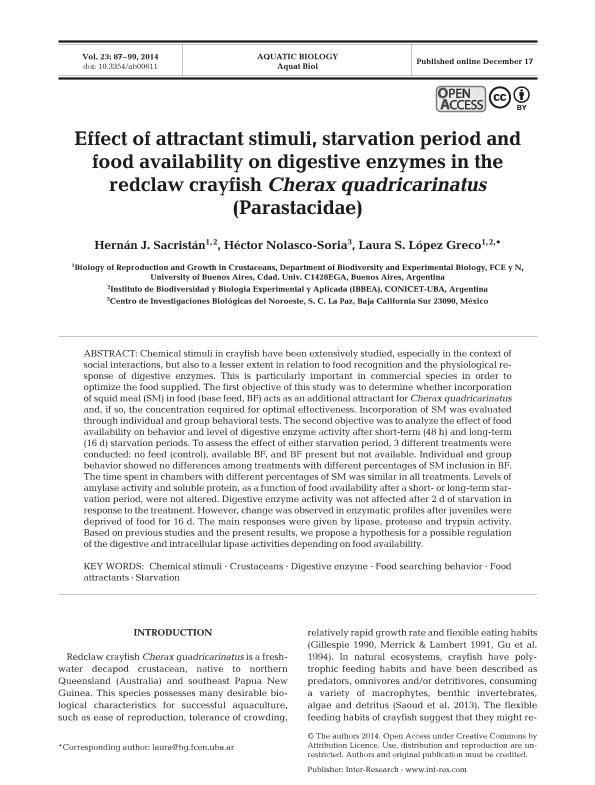Mostrar el registro sencillo del ítem
dc.contributor.author
Sacristán, Hernán Javier

dc.contributor.author
Nolasco Soria. Héctor
dc.contributor.author
Lopez, Laura Susana

dc.date.available
2017-07-04T18:56:27Z
dc.date.issued
2014-12
dc.identifier.citation
Sacristán, Hernán Javier; Nolasco Soria. Héctor; Lopez, Laura Susana; Effect of attractant stimuli, starvation period and food availability on digestive enzymes in the redclaw crayfish Cherax quadricarinatus (Parastacidae); Inter-Research; Aquatic Biology; 23; 1; 12-2014; 87-99
dc.identifier.issn
1864-7790
dc.identifier.uri
http://hdl.handle.net/11336/19495
dc.description.abstract
Chemical stimuli in crayfish have been extensively studied, especially in the context of social interactions, but also to a lesser extent in relation to food recognition and the physiological response of digestive enzymes. This is particularly important in commercial species in order to optimize the food supplied. The first objective of this study was to determine whether incorporation of squid meal (SM) in food (base feed, BF) acts as an additional attractant for Cherax quadricarinatus and, if so, the concentration required for optimal effectiveness. Incorporation of SM was evaluated through individual and group behavioral tests. The second objective was to analyze the effect of food availability on behavior and level of digestive enzyme activity after short-term (48 h) and long-term (16 d) starvation periods. To assess the effect of either starvation period, 3 different treatments were conducted: no feed (control), available BF, and BF present but not available. Individual and group behavior showed no differences among treatments with different percentages of SM inclusion in BF. The time spent in chambers with different percentages of SM was similar in all treatments. Levels of amylase activity and soluble protein, as a function of food availability after a short- or long-term starvation period, were not altered. Digestive enzyme activity was not affected after 2 d of starvation in response to the treatment. However, change was observed in enzymatic profiles after juveniles were deprived of food for 16 d. The main responses were given by lipase, protease and trypsin activity. Based on previous studies and the present results, we propose a hypothesis for a possible regulation of the digestive and intracellular lipase activities depending on food availability.
dc.format
application/pdf
dc.language.iso
eng
dc.publisher
Inter-Research

dc.rights
info:eu-repo/semantics/openAccess
dc.rights.uri
https://creativecommons.org/licenses/by-nc-sa/2.5/ar/
dc.subject
Chemical Stimuli
dc.subject
Crustaceans
dc.subject
Digestive Enzyme
dc.subject
Food Searching Behavior
dc.subject
Food Attractants
dc.subject
Starvation
dc.subject.classification
Otros Tópicos Biológicos

dc.subject.classification
Ciencias Biológicas

dc.subject.classification
CIENCIAS NATURALES Y EXACTAS

dc.title
Effect of attractant stimuli, starvation period and food availability on digestive enzymes in the redclaw crayfish Cherax quadricarinatus (Parastacidae)
dc.type
info:eu-repo/semantics/article
dc.type
info:ar-repo/semantics/artículo
dc.type
info:eu-repo/semantics/publishedVersion
dc.date.updated
2017-07-04T15:32:06Z
dc.journal.volume
23
dc.journal.number
1
dc.journal.pagination
87-99
dc.journal.pais
Alemania

dc.journal.ciudad
Oldendorf/Luhe
dc.description.fil
Fil: Sacristán, Hernán Javier. Consejo Nacional de Investigaciones Científicas y Técnicas. Oficina de Coordinación Administrativa Ciudad Universitaria. Instituto de Biodiversidad y Biología Experimental y Aplicada. Universidad de Buenos Aires. Facultad de Ciencias Exactas y Naturales. Instituto de Biodiversidad y Biología Experimental y Aplicada; Argentina
dc.description.fil
Fil: Nolasco Soria. Héctor. Centro de Investigaciones Biológicas del Noroeste; México
dc.description.fil
Fil: Lopez, Laura Susana. Consejo Nacional de Investigaciones Científicas y Técnicas. Oficina de Coordinación Administrativa Ciudad Universitaria. Instituto de Biodiversidad y Biología Experimental y Aplicada. Universidad de Buenos Aires. Facultad de Ciencias Exactas y Naturales. Instituto de Biodiversidad y Biología Experimental y Aplicada; Argentina
dc.journal.title
Aquatic Biology

dc.relation.alternativeid
info:eu-repo/semantics/altIdentifier/doi/http://dx.doi.org/10.3354/ab00611
dc.relation.alternativeid
info:eu-repo/semantics/altIdentifier/url/http://www.int-res.com/abstracts/ab/v23/n1/p87-99/
Archivos asociados
